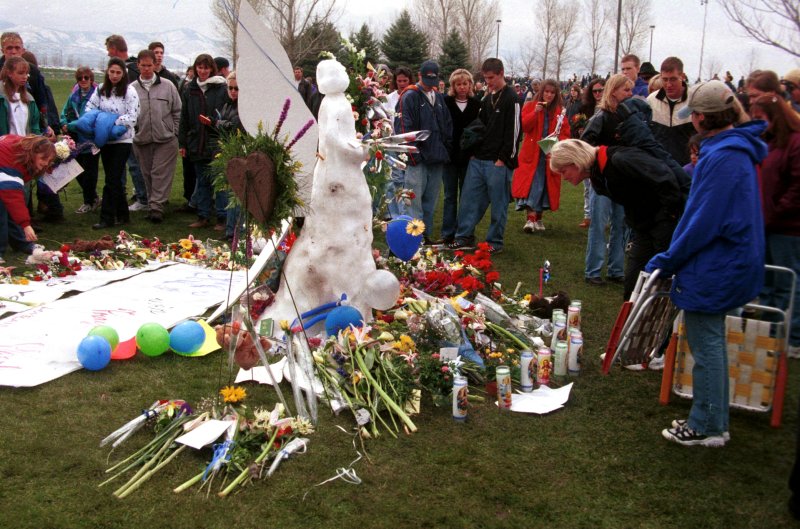LITTLETON, Colo. -- A group of people gathered around an angel made of snow in Clement Park adjancent to Columbine High School April 25, 1999, in a public outpouring of sympathy. Dylan Klebold and Eric Harris terrorized the school, killing one teacher and 12 students before taking their own lives. Government statistics indicate schools are safer now. RW/jr/Jim Ruymen UPI |
License Photo
The shooting at a high school in suburban Cleveland last week that left three students dead grabbed headlines, as did a double stabbing at an alternative school on Chicago's South Side.
Schools are more dangerous than ever, right? Not according to data released last month by the Departments of Justice and Education. School violence is actually on the decline.
Preliminary data from a report by the National Center for Education Statistics, Institute of Education Sciences and the Bureau of Justice Statistics show there were 33 school-associated violent deaths from July 1, 2009, through June 30, 2010. Those figures -- the most current available -- include students, staff and others who were on school grounds. Of those deaths, 25 were homicides, five were suicides and three were legal interventions. Seventeen of the homicides were students ages 5 to 18.
The figures are the lowest since 1992 when officials started tracking school violence, the report said. Shootings and other violent deaths in schools represent less than 2 percent of the homicides involving children ages 5 to 18, the data suggest.
Amanda Nickerson, director of the University at Buffalo's Alberti Center for the Prevention of Bullying Abuse, says schools are actually far safer for some children than their own homes; however, even one violent death at school is too much, she said.
There is no accurate profile for a school shooter, officials have said. A 2002 study by the Secret Service and the Department of Education found the shooters came from a variety of racial and ethnic backgrounds. They ranged in age from 11 to 21 years and were anything from excellent to failing students. Less than a third had histories of drug or alcohol abuse. Some came from intact families while others came from foster homes with histories of neglect, the National Institutes for Justice Journal said in 2009.
One trait that does stand out in the statistics is the finding that 71 percent of school shooters said they had felt bullied, persecuted, threatened or been attacked by others. Government figures released last month said 23 percent of public schools reported bullying occurred among students on a daily or weekly basis
Nickerson, a licensed psychologist and expert in school crisis prevention and intervention, says the efforts of Lady Gaga and other celebrities to combat bullying can be a highly effective way to help young people understand the seriousness of bullying.
The Born This Way Foundation, officially unveiled last week at a conference held at Harvard University, was created by Lady Gaga and her mother to address issues of self-confidence, well-being and bullying.
"BTWF will lead youth into a braver new society where each individual is accepted and loved as the person they were born to be, the foundation said in a release. "The Foundation is dedicated to creating a safe community where individuality is celebrated by connecting youth with the skills, resources and opportunities they need to build a braver, kinder world."
Nickerson said she is impressed with Lady Gaga's message. "I feel like she has done her homework in terms of her research," Nickerson told UPI. "I really think she can really speak to youth. She can't do it alone and she doesn't have all the answers ... but I definitely think it's going to help."
Nickerson said the most successful anti-bullying programs are comprehensive, involving not just the schools but also parents and the community.
She said schools need to make sure their anti-bullying programs educate the students about bullying and and also teach them assertiveness skills, empathy and how to manage emotions. It's not just saying "bullying is wrong" but creating a culture where it's not acceptable and where kids and adults will step up to intervene, Nickerson said.















